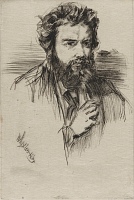Etchings Institutions search term: hughes kimber
Z. Astruc, Editor of 'L'Artiste' | ||
| Number: | 36 | |
| Date: | 1859 | |
| Medium: | drypoint | |
| Size: | 230 x 154 mm | |
| Signed: | 'Whistler - ' at lower left | |
| Inscribed: | '1859.' at lower left | |
| Set/Publication: | 'Cancelled Plates', 1879 | |
| No. of States: | 3 | |
| Known impressions: | 21 | |
| Catalogues: | K.53; M.53; T.66; W.49 | |
| Impressions taken from this plate (21) | ||

The copper plate bears the maker's rectangular stamp of 'HUGHES & KIMBER / MANUFACTURERS/ RED LION SQUARE / FLEET STREET / LONDON'. The same stamp appears on three Thames plates of 1859 of the same size, Thames Police
[53], Stevens' Boat Yard
[56] and Black Lion Wharf
[54], as well as on several portrait plates, all of 1859/1860. 14
Originally some figures appeared at the bottom of the plate, as printed in the first state. These were not by Whistler, which showed that he was re-using an old plate that had been worked on by someone else. Whistler wrote 'figures not mine -' on this impression ( ). In some impressions an earlier inscription on the plate is visible, which reads 'LamonT' and 'Lammont' (with the 'L' reversed) (see
). In some impressions an earlier inscription on the plate is visible, which reads 'LamonT' and 'Lammont' (with the 'L' reversed) (see  ). This suggests that the plate had been worked on by Thomas Reynolds Lamont (1826-1898), who was a fellow student of Whistler's in Paris. In 1857 Whistler had tried to persuade several of his fellow pupils including Lamont to try their hand at etching. Thomas Armstrong (1832-1911) described the occasion:
). This suggests that the plate had been worked on by Thomas Reynolds Lamont (1826-1898), who was a fellow student of Whistler's in Paris. In 1857 Whistler had tried to persuade several of his fellow pupils including Lamont to try their hand at etching. Thomas Armstrong (1832-1911) described the occasion:
Originally some figures appeared at the bottom of the plate, as printed in the first state. These were not by Whistler, which showed that he was re-using an old plate that had been worked on by someone else. Whistler wrote 'figures not mine -' on this impression (
 ). In some impressions an earlier inscription on the plate is visible, which reads 'LamonT' and 'Lammont' (with the 'L' reversed) (see
). In some impressions an earlier inscription on the plate is visible, which reads 'LamonT' and 'Lammont' (with the 'L' reversed) (see  ). This suggests that the plate had been worked on by Thomas Reynolds Lamont (1826-1898), who was a fellow student of Whistler's in Paris. In 1857 Whistler had tried to persuade several of his fellow pupils including Lamont to try their hand at etching. Thomas Armstrong (1832-1911) described the occasion:
). This suggests that the plate had been worked on by Thomas Reynolds Lamont (1826-1898), who was a fellow student of Whistler's in Paris. In 1857 Whistler had tried to persuade several of his fellow pupils including Lamont to try their hand at etching. Thomas Armstrong (1832-1911) described the occasion:
'Whistler took up etching in 1857, a process with which he was already familiar. He was very keen about it, and suggested that we all get plates and try our hands. It was decided that each should choose his own subject, and that prints from the plates should be sent to some literary person in England, and he should build up from them a story for publication to be called "Plawd", a word composed of the first letters of our names - Poynter, Lamont, Whistler, and Du Maurier ... Three of them were executed, Whistler's represented an interior.' 15
15: Lamont 1912 , p. 146.
There is no trace of an etching by Lamont but it may be that he did attempt a composition on this plate, and this was later burnished out and re-used by Whistler in 1859.
In 1872 an exhibition at the opening of the Guildhall Library and Museum of engraved portraits from the collection of James Anderson Rose (1819-1890) included portraits by Whistler, described as 'Nine portraits etched in copper - very rare - plates destroyed'. 16
Candidates for these nine portraits include Auguste Delâtre, Printer
[28],
Whistler with a hat
[44],
C. L. Drouet, Sculptor
[35],
Finette
[61], Z. Astruc, Editor of 'L'Artiste'
[36],
Arthur Haden
[66],
Mr Mann
[73],
Riault (The Wood Engraver)
[69] and
Axenfeld
[68]. Other possibilities include
Greenwich Pensioner
[40],
Bibi Valentin
[34],
Bibi Lalouette
[33] and
Fumette, Standing
[59].
16: Cat. nos. 960-68.
The copper plate was certainly cancelled, with diagonal lines across the face, before Whistler's bankruptcy in 1878. It was probably among plates bought at the bankruptcy sale by the Fine Art Society, London. It was published in the set of Cancelled Plates by the Fine Art Society in 1879.
The copper plate was probably among those acquired from Robert Dunthorne (b. ca 1851), by Rosalind Birnie Philip (1873-1958) in exchange for a number of lithographs. 17
The plate was later given by Miss Philip to the University of Glasgow in 1935. She owned two of the cancelled sets; one of these was cut up, and the rather mangled impressions were stuck on the envelopes containing the plates ( ).
).
The copper plate was probably among those acquired from Robert Dunthorne (b. ca 1851), by Rosalind Birnie Philip (1873-1958) in exchange for a number of lithographs. 17
The plate was later given by Miss Philip to the University of Glasgow in 1935. She owned two of the cancelled sets; one of these was cut up, and the rather mangled impressions were stuck on the envelopes containing the plates (
 ).
).17: Note by R. Birnie Philip, inserted in the album, Hunterian Art Gallery.
